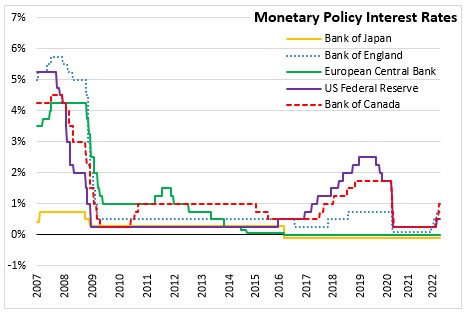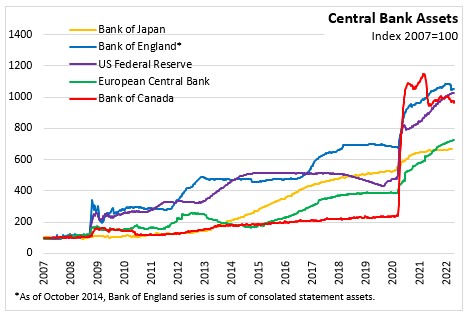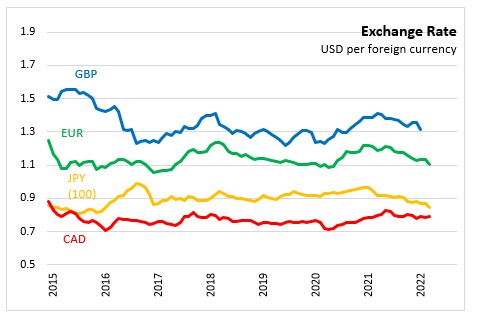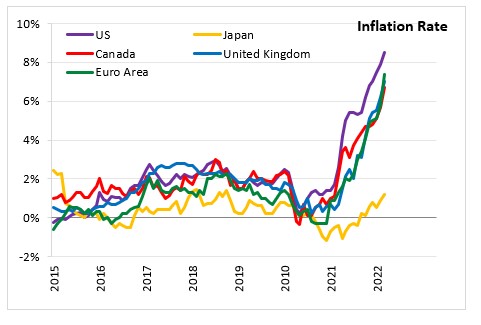The Economics and Statistics Division maintains archives of previous publications for accountability purposes, but makes no updates to keep these documents current with the latest data revisions from Statistics Canada. As a result, information in older documents may not be accurate. Please exercise caution when referring to older documents. For the latest information and historical data, please contact the individual listed to the right.
<--- Return to Archive
For additional information relating to this article, please contact:
April 28, 2022BANK OF JAPAN MONETARY POLICY The Policy Board of the Bank of Japan decided to maintain a negative interest rate of 0.1% for the Policy-Rate Balances in current accounts held by financial institutions at the Bank. The Bank of Japan will also purchase a necessary amount of Japanese government bonds (JGBs) without setting an upper limit in order to keep the 10-year JGB yields at around zero per cent.
In addition, the Bank will purchase exchange-traded funds (ETFs) and Japan real estate investment trusts (J-REITs) so that their amounts outstanding will increase at annual paces with upper limits of about 12 trillion yen and about 180 billion yen, respectively. The Bank will purchase Commercial Paper (CP) and corporate bonds at about the same pace as before the COVID-19 pandemic with their amounts outstanding gradually returning to about 2 trillion yen for CP and about 3 trillion yen for corporate bonds.
The Bank will continue with "Quantitative and Qualitative Monetary Easing (QQE) with Yield Curve Control," aiming to achieve the price stability target of 2 per cent, as long as it is necessary for maintaining that target in a stable manner. The Bank also noted that it will continue expanding the monetary base until the year-on-year rate of increase in the observed CPI (all items less fresh food) exceeds 2 per cent and stays above the target in a stable manner.
Japan's economic activity continued to increase despite some weakness due to COVID-19. Exports and industrial production continue to increase as a trend. Corporate profits and business sentiment also continued to improve. The employment and income situation has remained relatively week despite improvements in some sectors. Housing investment has been flat.
Russia's invasion of Ukraine has created volatility in global financial and capital markets, and pushed up energy and commodity prices in items such as crude oil, natural gas, coal, and grains. Since Japan relies on imports for most of these commodities, increases in these prices cause an outflow of income from Japan and put a downward pressure on households' real income and corporate profits. However, Japan government's measures against oil price hikes and the accumulation of household savings are expected to mitigate downward pressure on income and the consequent negative impact on spending.
The year-on-year rate in the consumer price index (CPI, all items) was 1.2% in March 2022, up from 0.9% in February. Despite the reduction in mobile phone charges, the year-over-year rate of change in the CPI has been slightly positive, reflecting the increase in energy prices. Medium- to long-term inflation expectations have risen, though at a moderate pace relative to short-term expectations. The increase in actual inflation is expected to lead to a further rise in households' and firms' medium- to long-term inflation expectations and bring a wide range of price increases. The year-on-year rate of change in the CPI (all items less fresh food) is likely to increase temporarily to 1.9% in 2022 and moderate to 1.1% in 2023 and 2024.
Japan's economy is projected to continue growing at a pace above its potential growth rate, as the negative impact of high commodity prices wanes and a virtuous cycle from income to spending intensifies gradually in the overall economy. Japan's real GDP is expected to increase 2.9% in 2022 and 1.9% in 2023. These represent a downgrade from the Bank's January 2022 forecasts reflecting a resurgence of COVID-19 cases, the rise in commodity prices, and a slowdown in overseas economies.
The Bank of Japan noted that it will continue to closely monitor the impacts of the COVID-19 and will take additional easing measures if needed. The Bank expects short- and long-term policy interest rates to remain at their present or lower levels.




Source: Bank of Japan, Statement on Monetary Policy (Apr 28, 2022), Outlook for Economic Activity and Prices (April 2022)
<--- Return to Archive